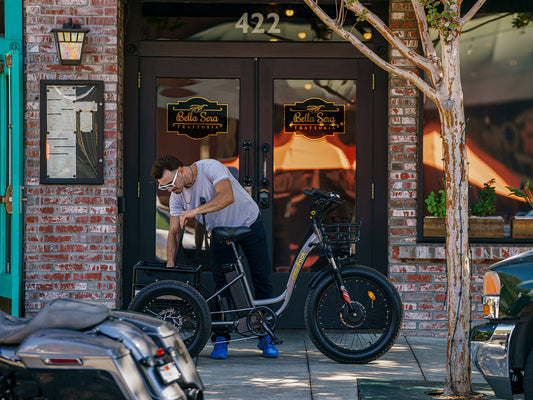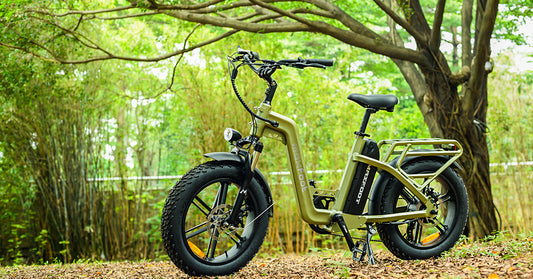Electric bicycles, or e-bikes, have transformed the cycling landscape, offering an eco-friendly mode of transportation. Choosing the right electric bike motor is a pivotal decision, with mid-drive and hub drive motors emerging as two distinct options.
Mid-Drive Electric Bicycle Motors
✅Crank Power
Situated at the crank or bottom bracket, mid-drive electric bicycle motors play a pivotal role by delivering power directly to the bike's chain and subsequently propelling the rear wheel. This innovative motor placement aims to emulate a natural pedaling experience for the rider, seamlessly integrating electric assistance into the cycling process.
By harnessing the energy at the core of the bicycle's drivetrain, mid-drive motors optimize efficiency and contribute to a more synchronized and intuitive riding sensation. This strategic positioning ensures that the power generated by the motor is efficiently transferred to the rear wheel, enhancing overall performance and creating a smoother, more responsive cycling experience.
The integration of mid-drive motors represents a significant advancement in electric bicycle technology, bridging the gap between traditional pedaling and electric assistance to offer cyclists a harmonious and enjoyable ride.
✅Efficient Power Distribution
Capitalizing on the inherent capabilities of the bicycle's gears, mid-drive electric bicycle motors excel in the realm of efficient power distribution. This strategic integration optimizes the utilization of energy, particularly evident during challenging scenarios such as hill climbs and diverse terrains.
By seamlessly interacting with the bike's gear system, mid-drive motors enable riders to maintain a comfortable cadence, regardless of the topography they encounter. This dynamic adaptability not only enhances the overall riding experience but also contributes to energy conservation, as the motor efficiently adjusts its power delivery to meet the demands of different riding conditions.
The harmonious collaboration between the mid-drive motor and the bicycle's gears exemplifies a sophisticated synergy, elevating the performance of electric bicycles and providing cyclists with a versatile and enjoyable journey across various landscapes.
✅Better Handling and Balance
The optimization of handling and balance emerges as a distinctive feature in mid-drive electric bicycle motors, driven by their centralized weight distribution. This strategic placement of the motor contributes significantly to the overall performance of e-bikes, rendering them well-suited for a myriad of riding conditions.
By concentrating the weight at the center of the bike, mid-drive systems achieve a harmonious balance, ensuring riders experience enhanced stability and control. This not only facilitates smoother navigation through various terrains but also makes mid-drive e-bikes particularly adept at tackling diverse riding conditions. Whether maneuvering through city streets or traversing off-road trails, the centralized weight distribution of mid-drive motors provides riders with a heightened sense of confidence and responsiveness.
In essence, the synergy between superior handling and balanced weight distribution establishes mid-drive e-bikes as versatile and reliable companions for cyclists seeking an optimal riding experience across a spectrum of environments.
✅Ideal for Off-Roading
Celebrated for their prowess in off-road and mountain biking adventures, mid-drive electric bicycle motors emerge as the ideal choice for enthusiasts seeking an exhilarating and versatile riding experience. The unique capabilities of mid-drive motors become particularly evident when navigating through diverse terrains and challenging inclines. Their adaptability shines as they seamlessly tackle varying landscapes, providing riders with a dynamic and responsive performance.
The intrinsic advantages of mid-drive systems extend beyond conventional cycling scenarios, showcasing their ability to conquer rough trails and conquer steep ascents with unparalleled efficiency. The centralized positioning of the motor enhances stability, ensuring a balanced distribution of weight that contributes to optimal traction on uneven surfaces. This specialized design not only enhances the overall off-road experience but also empowers cyclists to confidently explore new and rugged environments.
In essence, mid-drive motors redefine the off-roading experience, offering a harmonious blend of power, adaptability, and control. Whether navigating rocky paths or conquering uphill challenges, riders can rely on mid-drive electric bicycles to elevate their off-road escapades, making them an indispensable choice for those who crave the thrill of exploration in diverse and challenging terrains.
✅Costlier and Complex
While the advantages of mid-drive electric bicycle motors are undeniable, it's crucial to acknowledge that they come with a trade-off – a higher cost and increased complexity in both installation and maintenance. The sophistication and performance benefits offered by mid-drive systems are accompanied by a financial investment that reflects their advanced engineering.
The costlier nature of mid-drive motors is primarily attributed to their intricate design and the technology involved in seamlessly integrating the motor into the bike's drivetrain. This complexity extends to the installation process, where specialized knowledge and skills are often required. Cyclists opting for mid-drive e-bikes may find themselves facing higher upfront expenses, a factor that needs consideration when making a purchasing decision.
Furthermore, the maintenance of mid-drive motors demands a level of expertise beyond that required for traditional hub motors. The intricate interplay between the motor and the bike's gears necessitates periodic check-ups and adjustments to ensure optimal performance. While the benefits of mid-drive systems are undeniable, potential buyers should weigh the advantages against the associated costs and complexities, making an informed decision based on their riding needs, budget constraints, and willingness to engage in more involved maintenance practices.
Hub Drive Electric Bicycle Motors
✅Simplistic Integration
Nestled seamlessly into the wheel hub, hub drive electric bicycle motors present a streamlined and uncomplicated design, catering to riders in search of a straightforward and hassle-free e-bike experience. The integration of the motor within the hub of the wheel is a defining feature that contributes to the overall simplicity of these systems.
The appeal of hub drive motors lies in their user-friendly design, making them an excellent choice for individuals who prioritize ease of use and minimal maintenance. The straightforward integration eliminates the need for intricate drivetrain modifications, resulting in a more accessible and approachable electric biking solution. This simplicity not only enhances the aesthetics of the e-bike but also reduces the overall complexity of the system, appealing to a broad spectrum of riders, including those new to electric bicycles.
Beyond their mechanical advantages, hub drive motors align with the preferences of riders seeking a clean and uncluttered appearance. The unobtrusive nature of the hub integration allows for a sleek and minimalist design, creating an e-bike that seamlessly blends electric assistance with the classic aesthetic of a traditional bicycle. In essence, hub drive motors embody the fusion of simplicity and functionality, providing riders with a reliable and straightforward solution for incorporating electric power into their cycling endeavors.
✅Low Maintenance
The inherent simplicity of hub drive electric bicycle motors translates into a significant advantage when it comes to maintenance, making them an attractive choice for riders looking to minimize upkeep efforts and long-term ownership costs. The streamlined design of hub motors results in fewer moving parts compared to alternative motor configurations, reducing the likelihood of wear and tear.
This reduction in complexity not only enhances the reliability of hub drive motors but also makes them inherently easier to maintain. With fewer components susceptible to mechanical issues, riders can enjoy a more hassle-free experience, spending less time and resources on regular upkeep. The simplicity extends to routine checks and adjustments, contributing to an overall lower maintenance burden for e-bike owners.
The cost-effectiveness of hub drive motors becomes evident over time, as the decreased need for maintenance translates into reduced ownership costs. Riders benefit not only from the initial simplicity of the motor design but also from the long-term savings associated with lower maintenance requirements. In essence, hub drive electric bicycle motors exemplify a practical and economical solution for individuals seeking the benefits of electric assistance without the associated maintenance complexities, offering a reliable and cost-efficient alternative for the modern cyclist.
✅Suitable for Everyday Commuting
Tailored to meet the demands of urban commuting, hub drive electric bicycles emerge as an optimal choice, providing a reliable and efficient mode of transportation for daily travel. Their design is particularly well-suited for navigating cityscapes, delivering consistent power on flat terrain and ensuring a smooth and quiet operation, which proves advantageous in residential areas.
In the context of everyday commuting, the hub drive motors excel in offering a seamless riding experience. The consistent power delivery on level ground caters to the typical conditions encountered during city travel, allowing riders to effortlessly cruise through urban environments. This reliability is complemented by the quiet operation of hub motors, contributing to a more peaceful and unintrusive presence in residential neighborhoods.
The suitability of hub drive e-bikes for everyday commuting extends beyond their mechanical performance. Their user-friendly design, combined with the low maintenance requirements, aligns with the practical needs of commuters. The unobtrusive integration of the motor into the wheel hub also contributes to the overall aesthetic appeal of the e-bike, making it an attractive and functional choice for individuals navigating city streets on a daily basis. In essence, hub drive electric bicycles provide a versatile and convenient solution for urban commuters, combining consistent power delivery with a quiet and unassuming presence in residential areas.
✅Limited Efficiency on Inclines
While hub drive electric bicycle motors offer a range of advantages, it's essential to acknowledge a limitation that becomes apparent when tackling steep inclines – the lack of gear-shifting capability. This inherent characteristic can impact the efficiency of hub motors in challenging uphill scenarios, necessitating additional effort from riders to overcome elevation changes.
The absence of gear-shifting capability in hub drive motors contrasts with the adaptive nature of mid-drive systems that seamlessly interact with the bicycle's gears. In situations where steep hills demand a change in resistance, hub motors may face constraints in adjusting to the varying terrain. As a result, cyclists relying on hub drive e-bikes for hilly routes might find themselves exerting more energy and effort to maintain momentum.
It's important for riders to consider their intended routes and terrain when opting for hub drive e-bikes, as the limited efficiency on inclines might be a relevant factor in their overall riding experience. While hub drive motors excel in flat urban landscapes, potential users should weigh this limitation against the benefits and determine whether the trade-off aligns with their specific commuting or recreational needs, ensuring a well-informed decision based on the expected riding conditions.
✅Weight Distribution Concerns
One aspect that warrants attention in the context of hub drive electric bicycle motors is the potential for imbalanced weight distribution due to the motor's placement in the wheel hub. While hub motors offer a streamlined integration, this centralized positioning can have implications for the overall weight distribution of the e-bike, particularly impacting handling, especially when navigating rough or uneven terrain.
The concentration of the motor in the wheel hub alters the typical weight distribution found in traditional bicycles. This shift in balance can be noticeable, affecting the bike's handling characteristics, especially in situations where stability is crucial, such as off-road or bumpy terrains. Cyclists may experience a deviation from the balanced feel associated with bikes that distribute weight more evenly across the frame.
Riders considering hub drive e-bikes should be mindful of these weight distribution concerns, especially if their intended use involves varied terrains. While hub motors excel in certain environments, users may need to adapt their riding style on rougher surfaces to accommodate the potential handling differences. The trade-off between the simplicity of hub motors and the impact on weight distribution underscores the importance of aligning the choice of e-bike with individual preferences and the specific conditions it will encounter during use.
Conclusion
Choosing between mid-drive and hub drive electric bicycle motors depends on usage and preferences. For off-road enthusiasts and hilly terrains, mid-drive motors offer power and adaptability. Conversely, hub drive motors provide a low-maintenance, straightforward commuting option for city dwellers.
Test riding both types is essential to gauge differences in power delivery and the overall ride experience. The ideal choice aligns with individual needs and intended riding styles. With the expanding variety of e-bike models, finding the perfect option is accessible to every rider.




